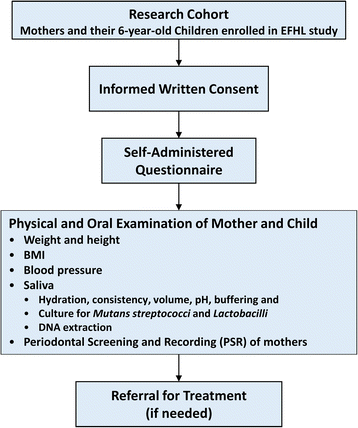Protocol for assessing maternal, environmental and epigenetic risk factors for dental caries in children
- PMID: 26715445
- PMCID: PMC4696221
- DOI: 10.1186/s12903-015-0143-2
Protocol for assessing maternal, environmental and epigenetic risk factors for dental caries in children
Abstract
Background: Expenditure on dental and oral health services in Australia is $3.4 billion AUD annually. This is the sixth highest health cost and accounts for 7 % of total national health expenditure. Approximately 49 % of Australian children aged 6 years have caries experience in their deciduous teeth and this is rising. The aetiology of dental caries involves a complex interplay of individual, behavioural, social, economic, political and environmental conditions, and there is increasing interest in genetic predisposition and epigenetic modification.
Methods: The Oral Health Sub-study; a cross sectional study of a birth cohort began in November 2012 by examining mothers and their children who were six years old by the time of initiation of the study, which is ongoing. Data from detailed questionnaires of families from birth onwards and data on mothers' knowledge, attitudes and practices towards oral health collected at the time of clinical examination are used. Subjects' height, weight and mid-waist circumference are taken and Body Mass Index (BMI) computed, using an electronic Bio-Impedance balance. Dental caries experience is scored using the International Caries Detection and Assessment System (ICDAS). Saliva is collected for physiological measures. Salivary Deoxyribose Nucleic Acid (DNA) is extracted for genetic studies including epigenetics using the SeqCap Epi Enrichment Kit. Targets of interest are being confirmed by pyrosequencing to identify potential epigenetic markers of caries risk.
Discussion: This study will examine a wide range of potential determinants for childhood dental caries and evaluate inter-relationships amongst them. The findings will provide an evidence base to plan and implement improved preventive strategies.
Figures
Similar articles
-
Significant caries and the interactive effects of maternal-related oral hygiene factors in urban preschool children.J Public Health Dent. 2017 Jun;77(3):188-196. doi: 10.1111/jphd.12183. Epub 2016 Nov 10. J Public Health Dent. 2017. PMID: 27861912
-
Association between knowledge of caries preventive practices, preventive oral health habits of parents and children and caries experience in children resident in sub-urban Nigeria.BMC Oral Health. 2014 Dec 16;14:156. doi: 10.1186/1472-6831-14-156. BMC Oral Health. 2014. PMID: 25516332 Free PMC article.
-
Caries is the main cause for dental pain in childhood: findings from a birth cohort.Caries Res. 2012;46(5):488-95. doi: 10.1159/000339491. Epub 2012 Jul 14. Caries Res. 2012. PMID: 22813889
-
Genetic factors affecting dental caries risk.Aust Dent J. 2015 Mar;60(1):2-11. doi: 10.1111/adj.12262. Aust Dent J. 2015. PMID: 25721273 Review.
-
Can social adversity alter the epigenome, trigger oral disease, and affect future generations?Ir J Med Sci. 2024 Oct;193(5):2597-2606. doi: 10.1007/s11845-024-03697-3. Epub 2024 May 14. Ir J Med Sci. 2024. PMID: 38740675 Free PMC article. Review.
Cited by
-
[Association between the dental caries and the human leucocyte antigen DQB1 allele polymorphisms among the Uygur and Han children in Xinjiang].Hua Xi Kou Qiang Yi Xue Za Zhi. 2018 Feb 1;36(1):4-8. doi: 10.7518/hxkq.2018.01.002. Hua Xi Kou Qiang Yi Xue Za Zhi. 2018. PMID: 29594988 Free PMC article. Chinese.
-
Tooth Decay: Genetic and Epigenetic Insights Driving the Development of Anti-Caries Vaccines.Genes (Basel). 2025 Aug 12;16(8):952. doi: 10.3390/genes16080952. Genes (Basel). 2025. PMID: 40869999 Free PMC article. Review.
-
The prevalence of dental caries and its associated factors among preschool children in Huizhou, China: a cross-sectional study.Front Oral Health. 2024 Aug 30;5:1461959. doi: 10.3389/froh.2024.1461959. eCollection 2024. Front Oral Health. 2024. PMID: 39280639 Free PMC article.
References
-
- Ismail AI, Sohn W, Tellez M, Willem JM, Betz J, Lepkowski J. Risk indicators for dental caries using the International Caries Detection and Assessment System (ICDAS) Community Dent Oral Epidemiol. 2008;36(1):55–68. - PubMed
Publication types
MeSH terms
Associated data
LinkOut - more resources
Full Text Sources
Other Literature Sources
Medical



